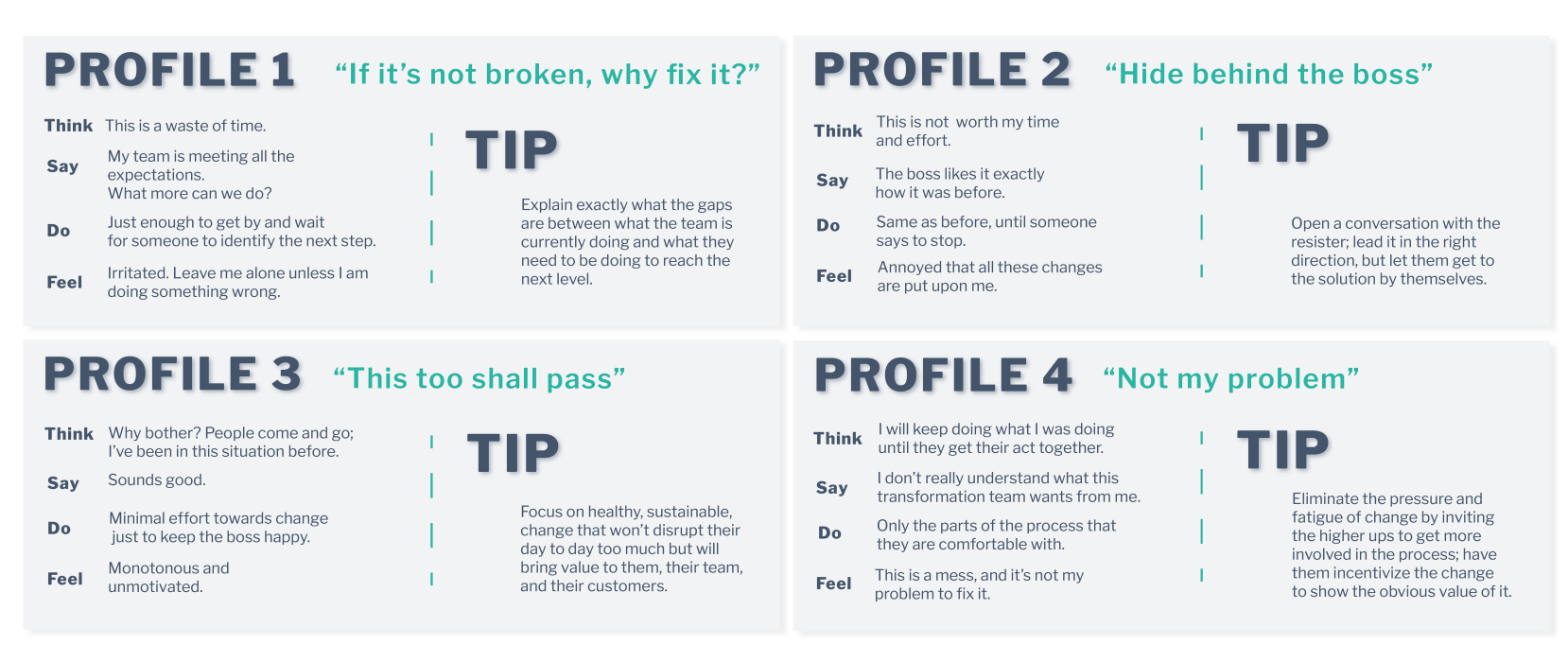INTRODUCTION
How do we coach through resistance? That is the million dollar question. As a coach, we often feel like we have all the answers and know the correct paths to success. True leaders aspire to influence and inspire people to make changes without forcing them, and though their reasoning for change may be sound, there will always be those who are more comfortable keeping things as they are.
In this article, we will discuss the types of resistance you may come across as an Agile coach, and some tips on how to coach through each one.
WHAT ARE RESISTANCE PROFILES, AND HOW TO COACH EACH TYPE
In collaboration with my colleague Michael Pullen, we developed four profiles to detail the types of resistance you may encounter during your coaching experience. Throughout my years of coaching, these four profiles have proven to be true not only to me, but to every coach I discuss them with.
In order to coach through resistance, no matter which profile you find yourself facing, you must first be able to answer the question that will most likely be at the top of the resister’s brain: “what’s in it for me?” I have categorized by name the four resistance profiles and combined them with what you, as an Agile coach, can expect when you come in contact with each one. At the end of each profile is a tip on how to regain control of the situation and lead the transformation towards a successful engagement.
Profile 1 "If it's not broken, why fix it?"
This profile type is the one to not see how change could make any difference in their day-to-day activities. They don’t know how it would benefit them, their team, their clients, etc. and understandably as a result, they do not see the point in taking unnecessary risks just for the sake of trying something new.
To win them over; explain exactly what the gaps are between what the team is currently doing and what they need to be doing to reach the next level. Help them to understand how achieving that will benefit them and allow them to communicate their concerns with you. Ultimately, if the changes do not solve any of Profile 1’s concerns then they will remain a resister.
Snapshot of recognizable behavior for Profile 1:
- Think- This is a waste of time.
- Say- My team is meeting all the expectations. What more can we do?
- Do- Just enough to get by and wait for someone to identify the next step.
- Feel- Irritated. Leave me alone unless I am doing something wrong.
Profile 2 "Hide behind the boss"
Most important to Profile 2 is their time. If they perceive a task, or change, as a waste of time then they see no point in even attempting it. Rather than face the music head on, however, they will use their boss (or someone else higher up) to blame for why they themselves cannot participate. As long as they hide behind this other hard-to-reach figure, Profile 2 is a difficult resister to get through to. The best way to get them on the side of change is to open a conversation with the resistor. By asking them leading questions they will feel more involved, heard, and understood. Even if the solution is obvious to you, direct the conversation towards it, but allow them reach it by themselves. Credit is not important when dealing with this kind of resister; implementing change is. Remember that, and you will experience success.
Snapshot of recognizable behavior for Profile 2:
- Think- This is not worth my time and effort.
- Say- The boss likes it exactly how it was before.
- Do- Same as before, until someone says to stop.
- Feel- Annoyed that all these changes are put upon me.
Profile 3 "This too shall pass"
A fatigued worker often becomes a resistant one. You will likely find Profile 3 at a company that has gone through multiple changes and transformations, but has yet to announce many success stories from them. The employees often adapt a passive mentality, choosing to think that this new change will also fail and not affect them whatsoever; so why should they make any effort? As a coach, you have the ability to communicate to them that you know and understand both their feelings and the company’s history. Explain to them how you have involved the higher ups in the process this time and as such the change is going to look different than it has before. Keep in mind that where there is fatigue, there is resistance and a general lack of excitement. That’s okay! Focus on healthy, sustainable, change that won't disrupt their day to day too much but will bring value to them, their team, and their customers. Take the pressure off by setting reasonable goals with more lenient timelines. Slow and steady wins this race.
Snapshot of recognizable behavior for Profile 3:
- Think- Why bother? People come and go; I've been in this situation before.
- Say- Sounds good.
- Do- Minimal effort towards change just to keep the boss happy.
- Feel- Monotonous and unmotivated.
Profile 4 "Not my problem"
Profile 4 emerges when disconnect between the objectives set within a business unit come to light. Often this appears in the form of miscommunication from the leaders of the transformation and the leaders of the business unit. Misalignment, confusion, and a greater tendency to resist the proposed change all rear their heads together in revolt.
Higher ups often do not change their business tactics, even when a coach is hired to come in and instill change. This can look like a 20 paged paper assignment being passed down to a single employee who is already working with a coach to restructure how tasks are delegated. The higher up who created the document has no way to understand that their task is disrupting the environmental change happening at the employee level if it is not being communicated to them. There must be alignment on an organizational level before the Agile coach comes in and begins work. If you are a coach in a similar situation, eliminate the pressure and fatigue of change by inviting the higher ups to get more involved in the process; have them incentivize the change to show the obvious value of it. In return, by them getting involved in the process, things will progress more efficiently and communication between departments and leads will improve.
Snapshot of recognizable behavior for Profile 4:
- Think- I will keep doing what I was doing until they get their act together.
- Say- I don't really understand what this transformation team wants from me.
- Do- Only the parts of the process that they are comfortable with.
- Feel- This is a mess, and it's not my problem to fix it.
CONCLUSION
Coaching can be a daunting task when faced with someone who is resistant to change. However, if you take the time to clearly articulate the value that your proposed changes will bring to an individual or a team, there is a good chance you will succeed in coaching through any kind of resistance. Take these profiles and tips with you on your next engagement to help guide you towards success.




